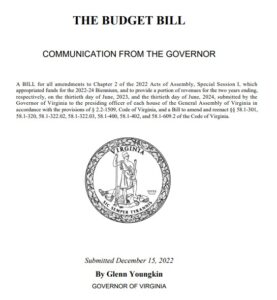 by Dick Hall-Sizemore
by Dick Hall-Sizemore
Budget is policy. The budget reflects the policy choices a government makes.
Any Virginia governor, upon assuming office, inherits a biennial budget proposal developed by his predecessor. The new governor is limited significantly in the changes that he can affect in that budget in his first General Assembly session. If the new governor is of a different party than the preceding one, it is likely that he will be bringing in a new senior financial team, as well as a new policy staff and cabinet. Because it takes time for these new staff members to become acclimated, it is not unusual for the new governor (by now, not so new) to propose mostly marginal changes in the mid-biennial budget he presents to the General Assembly. It is in his second year in office that a Virginia governor gets to propose a biennial budget that is truly his and which will bear his policy imprint.
Nevertheless, based on his campaign rhetoric and his promises after he assumed office, I expected Governor Youngkin to make substantial proposals — cutting or eliminating some programs, along with some major initiatives. By and large, however, his budget proposals build upon what was already in place when he took office. The possible exceptions are one instance (behavioral health) in which he has chosen to put new emphasis on one aspect and another, resiliency and protecting the Chesapeake Bay, for which he has proposed a surprisingly large increase in funding.
Steve Haner and I have informally split the commentary on the budget. For the most part, he handles revenue (i.e. tax policy) while I stick (usually) to the spending. This article will be a high-level summary of the budget general fund appropriations proposed by the Governor and follow-up articles will discuss specific areas in more detail.
The Governor is proposing an additional $2.9 billion in general fund appropriation for the biennium, an increase of 5%. The vast majority, $2.2 billion, is in the second year of the biennium and would be an increase of 7.8% percent in general fund appropriation for that fiscal year.
Although much of the publicity prior to the release of the budget centered around increased funding for mental health, that area did not get the largest share of the new funding. That honor went to economic development. Following are the top six policy areas in terms of increased funding, showing the biennial total (dollars shown in millions) and the percentage of total increase for the biennium of $2.9 billion being proposed for that area:
- Economic development–$470.7; 16.5%
- Resiliency/Bay–$457.3; 16.0%
- Public education and Lab schools–$422.3; 14.8%
- State employee bonus—$199.8; 7.0%
Nursing/General health and welfare–$159.9; 5.6% - Behavioral health–$149.1; 5.2%
These areas, and a few others, are the ones that get the media and legislative attention. However, scattered through any budget proposal are nuggets of interest. A perusal of the budget document, which sets out the changes to the underlying budget, along with short descriptions — items that would either delight one or cause consternation. There are more such items in the biennial budget proposal, but even the mid-biennial budget, whose primary purpose is to adjust the biennial budget, will have some head-scratchers. Here are a couple:
- $500,000 for security for the Lieutenant Governor
- $500,000 to plan and evaluate the potential economic incentives for the relocation of the National Football League team, the Washington Commanders, to Virginia. (Even the media picked up on this one.)
However, one will search in vain for the amendment that some on Bacon’s Rebellion have exhorted: additional funding for the Office of Licensure and Certification of the Department of Health.
Rather than go into detail here for these major funding areas and create a really long post, I am going to address each of them separately in smaller bites over the next few days.

Leave a Reply
You must be logged in to post a comment.